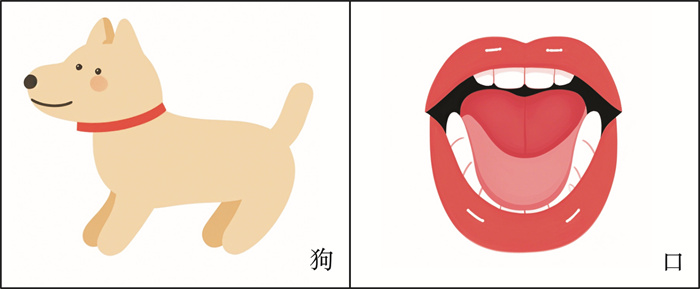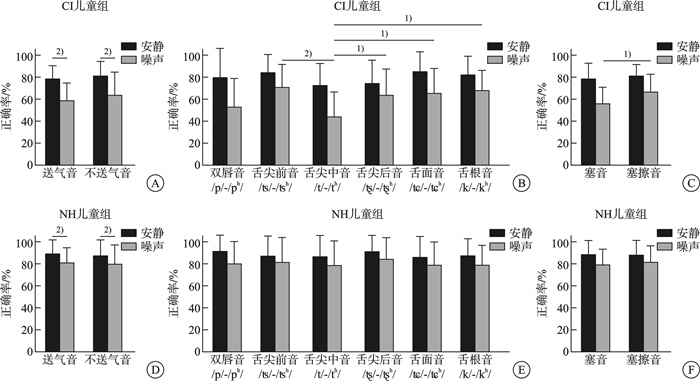Perception of Mandarin aspirated/unaspirated consonants in children with cochlear implants
-
摘要: 目的 研究人工耳蜗(CI)植入儿童在安静及噪声环境下对普通话辅音送气/不送气特征的感知能力。同时探索听觉条件、辅音发声部位、发声方式、年龄、植入年龄、智力等因素对CI儿童获得送气/不送气辅音的影响。 方法 选取2018—2023年植入CI的3~5岁儿童28例作为研究对象(CI组),同龄正常听力(NH)儿童88例作为对照(NH组)。分别测试2组儿童在安静及噪声条件下对送气/不送气辅音的识别能力,以及语音分辨能力、语音产出能力和非言语智力。探究组别(CI组和NH组)、听觉条件、辅音特征对儿童辅音识别的效应,并分析影响CI儿童获得送气/不送气辅音的因素。 结果 ① CI儿童的送气/不送气辅音感知能力落后于同龄NH儿童,2组比较差异有统计学意义(χ2=14.16,P<0.01),且识别能力还受辅音声学特征的影响(P<0.01);②CI儿童的送气/不送气辅音感知能力受噪声影响明显(P<0.01),且在噪声下的识别正确率还受到辅音发声方式的影响(P<0.05);③CI儿童年龄越小,其辅音感知能力越好(β=-0.223,P=0.012)。 结论 CI儿童对辅音送气/不送气特征的感知能力仍需提高。然而,早期CI植入对其言语感知能力的发展,特别是对细微语音特征的感知能力,具有一定优势。Abstract: Objective This study aims to investigate the perception of Mandarin aspirated and unaspirated consonants by children with cochlear implants (CIs) under quiet and noisy conditions. It also examines factors that may affect their acquisition, such as auditory conditions, place of articulation, manner of articulation, chronological age, age at implantation, and non-verbal intelligence. Methods Twenty-eight CI children aged 3 to 5 years who received implantation from 2018 to 2023 were recruited. Additionally, 88 peers with normal hearing (NH) were recruited as controls. Both groups participated in a perception test for aspirated/unaspirated consonants under quiet and noisy conditions, along with tests for speech recognition, speech production, and non-verbal intelligence. The study analyzed the effects of group (CI vs. NH), auditory condition, and consonant characteristics on children's perception of aspirated/unaspirated consonants in Mandarin, as well as the factors contributing to CI children's acquisition of these consonants. Results ① CI children's ability to perceive aspirated/unaspirated consonants was significantly poorer than that of their NH peers (χ2= 14.16, P < 0.01), and their perception accuracy was influenced by the acoustic features of consonants (P < 0.01); ②CI children's consonant perception abilities were adversely affected by noise (P < 0.01), with accuracy in noisy conditions particularly influenced by the manner of articulation (P < 0.05); ③The age at implantation significantly affected CI children's ability to perceive aspirated/unaspirated consonants (β= -0.223, P=0.012), with earlier implantation associated with better performance. Conclusion It takes time for CI children to acquire Mandarin aspirated/unaspirated consonants, and early implantation shows many advantages, especially for the perception ability of fine speech features.
-

-
表 1 2组受试儿童的基本信息
Min~Max,X±S 项目 NH组 CI组 年龄/岁 3.33~5.99(4.61±0.82) 3.18~5.96(4.54±0.88) 听力损失诊断年龄/岁 - 0.00~3.08(1.13±1.21) 植入年龄/岁 - 0.21~4.26(2.31±1.09) CI使用时长/年 - 0.65~4.93(2.47±0.93) 语音产出正确率/% 55.00~100.00(91.56±17.16) 13.00~86.00(50.50±8.16) 智力得分 64.00~125.00(106.52±14.01) 73.00~146.00(97.00±19.39) 表 2 Logistic回归结果
组别 相关因素 β SE Wald χ2 P OR(95%CI) CI组 年龄 -0.167 0.18 0.95 0.343 0.846(0.621,1.139) CI植入年龄 -0.172 0.08 12.36 <0.050 0.842(0.727,0.970) CI使用时长 0.050 0.09 0.30 0.578 1.051(0.876,1.252) 语音产出 <0.001 0.01 0.00 0.985 1.000(0.992,1.008) 智力水平 -0.003 0.01 0.57 0.449 0.997(0.989,1.005) NH组 年龄 0.503 0.06 8.43 <0.010 1.655(1.543,1.774) 语音产出 0.016 0.01 4.11 <0.050 1.016(1.004,1.028) 智力水平 0.008 <0.01 5.37 <0.010 1.008(1.003,1.014) -
[1] Khwaileh FA, Flipsen P Jr, Hammouri HM, et al. Acoustic characteristics of Arabic pharyngealized obstruents in children with cochlear implants[J]. J Acoust Soc Am, 2019, 146(2): 893-908.
[2] Meng Y, Chen F, Feng Y, et al. Age-Related Differences of Mandarin Tone and Consonant Aspiration Perception in Babble Noise[J]. J Speech Lang Hear Res, 2022, 65(9): 3438-3451.
[3] Ramteke PB, Supanekar S, Koolagudi SG. Classification of aspirated and unaspirated sounds in speech using excitation and signal level information[J]. Comput Speech Lang, 2020, 62(6): 101057.
[4] Lisker L, Abramson AS. A Cross-Language Study of Voicing in Initial Stops: Acoustical Measurements[J]. WORD, 1964, 20(3): 384-422.
[5] 刘亚丽, 齐娜, 陈静, 等. 普通话辅音嗓音起始时间VOT的声学统计分析[J]. 中国传媒大学学报(自然科学版), 2023, 30(3): 15-23.
[6] Feng Y, Peng G. Development of categorical speech perception in Mandarin-speaking children and adolescents[J]. Child Dev, 2023, 94(1): 28-43. doi: 10.1111/cdev.13837
[7] World Health Organization. World report on hearing[R/OL]. Geneva: WHO, 2021.
[8] 李葆嘉, 王彤. 幼儿语言的成长: 常用词汇语义系统建构[M]. 北京: 科学出版社, 2021: 43-210.
[9] 张显达, 郝燕, 赵冬梅, 等. 儿童语言发育词汇评估量表的信效度研究[J]. 中国听力语言康复科学杂志, 2024, 22(1): 23-26.
[10] McGhee R, Ehrler D. Primary Test of Nonverbal Intelligence Technical Manual[M]. Austin: PRO-ED, 2008: 1-75
[11] Zheng Y, Soli SD, Meng Z, et al. Assessment of Mandarin-speaking pediatric cochlear implant recipients with the Mandarin Early Speech Perception(MESP)test[J]. Int J Pediatr Otorhinolaryngol, 2010, 74(8): 920-925. doi: 10.1016/j.ijporl.2010.05.014
[12] Peng ZE, Hess C, Saffran JR, et al. Assessing Fine-Grained Speech Discrimination in Young Children With Bilateral Cochlear Implants[J]. Otol Neurotol, 2019, 40(3): e191-e197. doi: 10.1097/MAO.0000000000002115
[13] Grimm R, Pettinato M, Gillis S, et al. Simulating speech processing with cochlear implants: How does channel interaction affect learning in neural networks?[J]. PLoS One, 2019, 14(2): e0212134. doi: 10.1371/journal.pone.0212134
[14] Hedrick M, Thornton KET, Yeager K, et al. The Use of Static and Dynamic Cues for Vowel Identification by Children Wearing Hearing Aids or Cochlear Implants[J]. Ear Hear, 2020, 41(1): 72-81. doi: 10.1097/AUD.0000000000000735
[15] Varnet L, Langlet C, Lorenzi C, et al. High-Frequency Sensorineural Hearing Loss Alters Cue-Weighting Strategies for Discriminating Stop Consonants in Noise[J]. Trends Hear, 2019, 23: 2331216519886707. doi: 10.1177/2331216519886707
[16] McClaskey CM. Neural hyperactivity and altered envelope encoding in the central auditory system: Changes with advanced age and hearing loss[J]. Hear Res, 2024, 442: 108945.
[17] Wong LLN, Zhu S, Chen Y, et al. Discrimination of consonants in quiet and in noise in Mandarin-speaking children with normal hearing[J]. PLoS One, 2023, 18(3): e0283198.
[18] McFayden TC, Baskin P, Stephens JDW, et al. Cortical Auditory Event-Related Potentials and Categorical Perception of Voice Onset Time in Children With an Auditory Neuropathy Spectrum Disorder[J]. Front Hum Neurosci, 2020, 14: 184.
[19] Peng ZE, Easwar V. Development of amplitude modulation, voice onset time, and consonant identification in noise and reverberation[J]. J Acoust Soc Am, 2024, 155(2): 1071-1085.
[20] Sharma SD, Cushing SL, Papsin BC, et al. Hearing and speech benefits of cochlear implantation in children: A review of the literature[J]. Int J Pediatr Otorhinolaryngol, 2020, 133: 109984.
[21] Naik AN, Varadarajan VV, Malhotra PS. Early pediatric Cochlear implantation: An update[J]. Laryngoscope Investig Otolaryngol, 2021, 6(3): 512-521.
[22] Yuan D, Ng IH, Feng G, et al. The Extent of Hearing Input Affects the Plasticity of the Auditory Cortex in Children With Hearing Loss: A Preliminary Study[J]. Am J Audiol, 2023, 32(2): 379-390.
[23] Persic D, Thomas ME, Pelekanos V, et al. Regulation of auditory plasticity during critical periods and following hearing loss[J]. Hear Res, 2020, 397: 107976.
[24] Franchella S, Concheri S, Di Pasquale Fiasca VM, et al. Bilateral simultaneous cochlear implants in children: Best timing of surgery and long-term auditory outcomes[J]. Am J Otolaryngol, 2024, 45(2): 104124.
[25] Pardo JS, Remez RE. On the Relation between Speech Perception and Speech Production[M]//The Handbook of Speech Perception, Hoboken, NJ: Wiley-Blackwell, 2021: 632-655.
[26] An KM, Hasegawa C, Hirosawa T, et al. Brain responses to human-voice processing predict child development and intelligence[J]. Hum Brain Mapp, 2020, 41(9): 2292-2301.
[27] Wang Y, Seidl A, Cristia A. Infant speech perception and cognitive skills as predictors of later vocabulary[J]. Infant Behav Dev, 2021, 62: 101524.
[28] Kulasingham JP, Joshi NH, Rezaeizadeh M, et al. Cortical Processing of Arithmetic and Simple Sentences in an Auditory Attention Task[J]. J Neurosci, 2021, 41(38): 8023-8039.
-

计量
- 文章访问数: 183
- 施引文献: 0




 下载:
下载:


